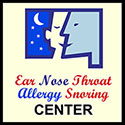Treatment for Snoring and Sleep Apnea
 Several good treatments available
Several good treatments available
While snoring and sleep apnea can be a cause for concern, there are several good treatment options available that your physician can tailor to your needs based on your medical history and a thorough physical examination. Your doctor will also order a polysomnography, or sleep study. This is performed at night while you are sleeping, and records your brain waves (to see what stage of sleep you are in, you respirations, oxygen level, heart rate, and body position during sleep. This will provide a good measure of your sleep and sleep apnea.
There are three types of sleep apnea:
-
- Obstructive Sleep Apnea occurs when the airway is obstructed because the muscles of the tongue and throat relax during sleep.
- Central Sleep Apnea happens when the diaphragm does not receive messages from the brain telling it to breathe.
- Mixed Sleep Apnea occurs when an individual suffers from both types of sleep apnea. It’s the most difficult to both treat and control.
For the most part, there are no effective medications for use in treatment of obstructive sleep apnea, the most common type. The most effective treatment in obese patients is weight loss. In practical terms the most effective treatment is to use a machine to blow air into the collapsed airway and keep it open. This is called a CPAP or Continuous Positive Airway Pressure machine.
Some patients have an anatomical airway obstruction such as a deviated septum or enlarged tongue. Fixing these problems either surgically or with devices which reposition the jaw at night may be helpful.
One of the things your doctor will discuss with you is changes in your behavior, some of which may have led to the development of sleep apnea. If you are overweight, your doctor will advise you to lose weight. Even a small amount of weight lost can help to alleviate symptoms. Your doctor will also tell you to avoid alcohol, tobacco and sleep medications, which may cause your airway to over-relax and collapse more easily, leading to a worsening of symptoms. And, finally, your doctor will tell you to sleep on your side, since this is the best position to avoid airway collapse.
One effective sleep apnea treatment is ‘nasal continuous positive airway pressure’, or CPAP for short. The patient wears a mask over his nose while sleeping, and an air blower gently forces slightly pressurized air through the nose and down the throat, effectively keeping the airway open. As long as the patient uses the CPAP machine while sleeping, sleep apnea symptoms will not re-occur.
There are some side effects associated with the use of the CPAP machine. Irritation of the nasal passages and facial skin, stomach bloating, sore eyes and headaches can occur. Some patients have found relief with a special dental appliance, fitted by a dentist or orthodontist, that repositions the patient’s lower jaw and tongue so that it does not contribute to airway collapse. This device is useful for those with mild to moderate sleep apnea and who, on examination, have an airway which opens with jaw positioning.
For some patients surgery is an option, although it does not work as well as CPAP in most patients, it DOES work much better than CPAP which the patient does not use. No sleep apnea surgery is 100% successful and, like all surgeries, there are risks. The patient may need removal of his adenoids and tonsils, or may discover growths such as nasal polyps, or deformities in the structure of the nose and throat. Surgery is generally more successful in easing sleep apnea symptoms when performed on younger patients.
One surgical procedure is Uvulopalatopharyngoplasty (UPPP), which removes excess tissue found at the back of the throat, including the tonsils, uvula, (the ‘bell” that hangs from the top of your palate) and part of the soft palate (the roof of your mouth). The success rate for this technique is not better than 50 percent for sleep apnea, although it is much more effective for snoring.
A variation of uvulopalatopharyngoplasty can now be performed with lasers and is called ‘laser-assisted uvulopalatoplasty (LAUP). Normally, this procedure is performed to eliminate snoring and has not yet proven effective for the treatment of sleep apnea.
For those suffering with severe sleep apnea that is life-threatening, physicians rarely recommend a Tracheostomy, a procedure in which a small hole is made in the patient’s windpipe, and a tube is then inserted into the hole and into the windpipe. During the day, the patient talks and breathes normally because the tube stays closed. At night, when the patient is sleeping, the tube is opened so that air can flow directly into the lungs. This is an effective way to bypass the nose and throat so that any obstructions do not interfere with the patient’s breathing. This is an extreme measure for treating sleep apnea.
Surgical reconstruction for those patients who suffer from lower jaw deformities that interfere with the natural ability to breathe properly when laying down. And, finally, for obese patients, surgery may be recommended to treat the obesity in order to effectively treat the sleep apnea.
The causes for sleep apnea vary so much from individual to individual and the effects of untreated sleep apnea are severe. Because the treatment is long term and affects the patient’s sleep, it is very important that the patient is evaluated by a physician familiar with the upper airway and the many treatment possibilities and that they work together to arrive at a solution which is effective and acceptable to the patient.
